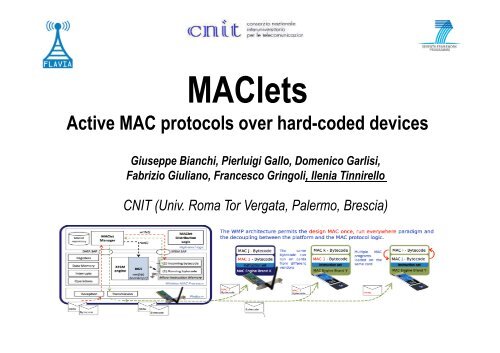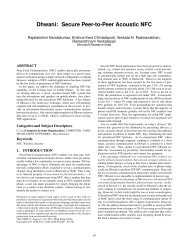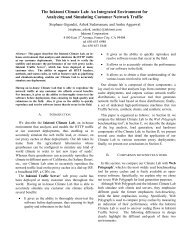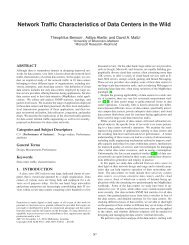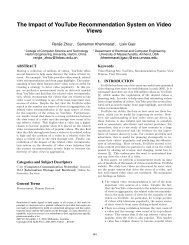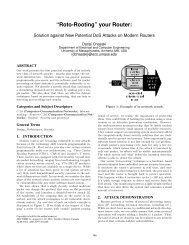Slides - Events
Slides - Events
Slides - Events
You also want an ePaper? Increase the reach of your titles
YUMPU automatically turns print PDFs into web optimized ePapers that Google loves.
MAClets<br />
Active MAC protocols over hard-coded devices<br />
Giuseppe Bianchi, Pierluigi Gallo, Domenico Garlisi,<br />
Fabrizio Giuliano, Francesco Gringoli, Ilenia Tinnirello<br />
CNIT (Univ. Roma Tor Vergata, Palermo, Brescia)
From STA<br />
management via<br />
parameter<br />
settings…<br />
To STA<br />
management via<br />
full MAC stack<br />
reprogramming!<br />
AP<br />
Use CW=63, AIFS=2, TXOP=5.2<br />
Configure via 802.11v params<br />
AP<br />
Install and run this MAC protocol<br />
Whole MAC protocol stack as a sort of JAVA applet?
Flexibily Adapt Access Protocol to<br />
scenario/context<br />
Dynamic spectrum access<br />
Niche scenario optimization<br />
home, industrial, …<br />
Context/application-specific protocol design<br />
Faster paper-to-field deployment<br />
Improved support for PHY enhancements<br />
Virtualization<br />
Each operator can design its own resource management<br />
frame forging, scheduling, timing, channel switching,<br />
PHY selection, …<br />
Different MAC coexisting on same AP/net
Lower MAC protocol ops are real time!<br />
O(us): TX, RX, slot times, set IFS, set timers, etc<br />
Driver to NIC interface: too slow MUST run on NIC<br />
Vendors will HARDLY give us open source, fully<br />
programmable, NICs<br />
SDR is 20 years old but…<br />
…still no real world commodity SDR NICs<br />
NIC design extensively leveraging HW<br />
non programmable, unless FPGA NICs…<br />
Your commodity card is NOT an FPGA!<br />
Why a vendor should renounce to its internal Intellectual Property??<br />
But even if stack gets opened…which programmability model?<br />
Current practice (in most cases):<br />
patch/hack existing SW/FW/HW code base<br />
Huge skills/experience, low level languages, slow development, inter-module<br />
dependencies
Exploiting a new abstraction model for<br />
run-time MAC protocol reconfigurations!<br />
based on the Wireless MAC Processor (WMP)<br />
INFOCOM 2012<br />
Enabling active MAC protocols and remote<br />
MAC injection<br />
Ultra-fast (below ms) reconfiguration<br />
MAC multi-threading<br />
Virtualization
1: Instruction sets<br />
perform elementary tasks on the platform<br />
A-priori given by the platform<br />
Can be VERY rich in special purpose computing platforms<br />
» Crypto accelerators, GPUs, DSPs, etc<br />
2: Programming languages<br />
sequence of such instructions + conditions<br />
Convey desired platform’s operation or algorithm<br />
3: Central Processing Unit (CPU)<br />
execute program over the platform<br />
Unaware of what the program specifically does<br />
Fetch/invoke instructions, update registers, etc<br />
Clear decoupling between:<br />
- platform’s vendor implements (closed source!) instruction set & CPU<br />
- programmer produces SW code in given language
ACTIONS<br />
frame management, radio control, time scheduling<br />
TX frame, set PHY params, RX frame,<br />
set timer, freeze counter, build header,<br />
forge frame, switch channel, etc<br />
EVENTS<br />
available HW/SW signals/interrupts<br />
Busy channel signal, RX indication,<br />
inqueued frame, end timer, etc<br />
CONDITIONS<br />
boolean/arithmetic tests on available registers/info<br />
Frame address == X, queue length >0,<br />
ACK received, power level < P, etc
Convenient “language”: XFSM<br />
eXtended Finite State Machines<br />
Compact way for composing available acts/ev/cond<br />
to form a custom MAC protocol logic<br />
Origin<br />
state<br />
EVENT<br />
(condition)<br />
Action()<br />
Destination<br />
state<br />
config action()<br />
Destination<br />
state<br />
Destination<br />
state
MAC engine: specialized XFSM<br />
executor (unaware of MAC logic)<br />
Fetch state<br />
Receive events<br />
Verify conditions<br />
Perform actions and state transition<br />
Once-for-all “vendor”-implemented<br />
in NIC (no need for open source)<br />
“close” to radio resources = straightforward realtime<br />
handling
MAC description:<br />
XFSM<br />
XFSM tables<br />
Transitions<br />
A<br />
B<br />
C<br />
«byte»-code event, condition, action<br />
Portable over different vendors’<br />
devices, as long as API is the same!!<br />
Pack & optimize in WMP «machinelanguage»<br />
bytecode<br />
A<br />
T(A,B)<br />
T(C,A) T(C,B)<br />
C<br />
B<br />
A B C<br />
A<br />
B<br />
C<br />
T(B,C)<br />
T(A,B)<br />
T(B,C)<br />
T(C,A) T(C,B)<br />
MAC protocol specification:<br />
XFSM design<br />
(e.g. Eclipse GMF)<br />
Machine-readable code<br />
Custom language compiler<br />
Code injection<br />
in radio HW platform<br />
MAC Bytecode<br />
MAC Engine
The MAC Engine does not<br />
need to know to which MAC<br />
program a new fetched state<br />
belongs!<br />
Code switching can be easily<br />
supported by moving to a state in a<br />
different transition table<br />
It is enough to:<br />
Define Meta State Machines for<br />
programming code switching<br />
Verify MAC switching events from<br />
each state of the program under<br />
execution<br />
Re-load system configuration<br />
registers at MAC transitions<br />
switching events
Upload MAC program on NIC from remote<br />
While another MAC is running<br />
Embed code in ordinary packets<br />
WMP Control<br />
Primitives<br />
load(XFSM)<br />
run(XFSM)<br />
verify(XFSM)<br />
switch(XFSM1, XFSM2, ev,<br />
cond)<br />
Further primitives<br />
Distribution protocol (run by<br />
the MAClet Manager<br />
Synchro support for<br />
distributed start of same<br />
MAC operation)<br />
“Bios” state machine: DEFAULT protocol (e.g. wifi) which all terminals understand
An entire MAC program can<br />
be coded in a single frame!<br />
our abstractions and machine codes<br />
allow to code DCF in about 500 bytes<br />
Other fields:<br />
type (distribution protocol and action messages)<br />
destination IDs<br />
initial state<br />
command (load, run, switch..)<br />
activation event<br />
MACLET<br />
CODE<br />
TYPE ID ID ID CMD STATE TABLE EVENT
Defined for allow the AP to remotely access the WMP<br />
control interface of the associated nodes<br />
Binding MAClet Managers of each node to the AP MAClet Controller<br />
Notification of activation/de-activation, ID assignment<br />
Transporting Action Messages coding WMP commands (load/run/switch)<br />
and MAC programs
When to switch to a new MAC protocol?<br />
Mechansims available, but final solutions left to the MAClet programmers<br />
Triggering events and signals<br />
No trigger: asynchronous activation<br />
Control frames sent by the AP<br />
Expiration of relative or absolute timer<br />
Absolute timers built on top of the time-synchronization function included in DCF<br />
1-way or 3-way handshakes<br />
switch at<br />
next bcn!
From a configuration to another..<br />
From a program to another!<br />
(with latency of about 1 microsecond)
Reference platform: broadcom Airforce54g 4311/4318<br />
WMP:<br />
replace both Broadcom and openFWWF firmware with<br />
Implementation of actions, events, conditions<br />
MAC engine: XFSM executor<br />
Develop “machine language” for MAC engine<br />
Custom made “bytecode” specified and implemented<br />
WMP Control Architecture:<br />
At firmare level:<br />
WMP Control Interface<br />
At the application level:<br />
MAClet Manager: receive/transmit MAClets and other messages of the MAClet<br />
Distribution Protocol<br />
MAClet Controller: Intelligent part of the system, dealing with network-level<br />
decisions<br />
Current implementation based on classical client-server model!
Two operators on same<br />
AP/infrastructure<br />
A: wants TDM, fixed rate<br />
B: wants best effort DCF<br />
Trivial with MAClets!<br />
Customers of A/B download<br />
respective TDM/DCF MAClets!<br />
Isolation via MAClet design<br />
Timer expiration<br />
DCF SUSPEND<br />
Time slicing DESIGNED INTO the MAClets! (static or dynamic)<br />
Beacon reception & conversely
Heterogeneous applications at home<br />
E.g. Video streaming and web browsing<br />
Trivial with MAClets!<br />
The Smart TV is not expected to implement any<br />
specific standard amendment<br />
DLS protocol can be loaded when necessary<br />
The network owner can push further optimizations:<br />
additional channel for direct link channel, without<br />
losing association<br />
Additional channel for direct link with greedy backoff
Experiment with a periodic switching from DLS++ to DCF<br />
For testing multithreading and synchronization mechanisms
New vision:<br />
MAC no more an all-size-fits-all protocol<br />
Can be made context-dependent<br />
Complex scenarios (e.g. virtualization) become trivial!<br />
Very simple and viable model<br />
Byte-coded XFSM injection<br />
Does NOT require open source NICs!<br />
Next steps<br />
We focused on the «act» phase; what about the decision and<br />
cognitive plane using such new weapons?<br />
can we think to networks which «self-program» themselves?<br />
Not too far, as it just suffices to generate and inject a state<br />
machine…
Supported by the FLAVIA EU FP7 project<br />
http://www.ict-flavia.eu/<br />
general coordinator: giuseppe.bianchi@uniroma2.it<br />
Technical coordinator: ilenia.tinnirello@tti.unipa.it<br />
Public domain release in alpha version<br />
https://github.com/ict-flavia/Wireless-MAC-Processor.git<br />
Developer team:<br />
ilenia.tinnirello@tti.unipa.it<br />
domenico.garlisi@dieet.unipa.it<br />
fabrizio.giuliano@dieet.unipa.it<br />
francesco.gringoli@ing.unibs.it<br />
Released distribution:<br />
Binary image for WMP<br />
Source code for MAClet Manager<br />
You DO NOT need it open source!<br />
Remember the “hard-coded” device philosophy…<br />
Conveniently mounted and run on Linksis or Alix<br />
Source code for everything else<br />
Manual & documentation, sample programs
MAC Engine: XFSM executor<br />
Memory blocks: data, prog<br />
Registers: save system state<br />
(conditions);<br />
Interrupts block passing HW<br />
signals to Engine (events);<br />
Operations invoked by the<br />
engine for driving the<br />
hardware (actions)<br />
The MAC engine works as a<br />
Virtual MAC Machine
Actions:<br />
set_timer, stop_timer,<br />
set_backoff,<br />
resume_backoff,<br />
update_cw,<br />
switch_TX, TX_start<br />
<strong>Events</strong>:<br />
END_TIMER,<br />
QUEUE_OUT_UP,<br />
CH_DOWN, CH_UP,<br />
END_BK,<br />
MED_DATA_CONF<br />
Conditions:<br />
medium, backoff,<br />
queue


